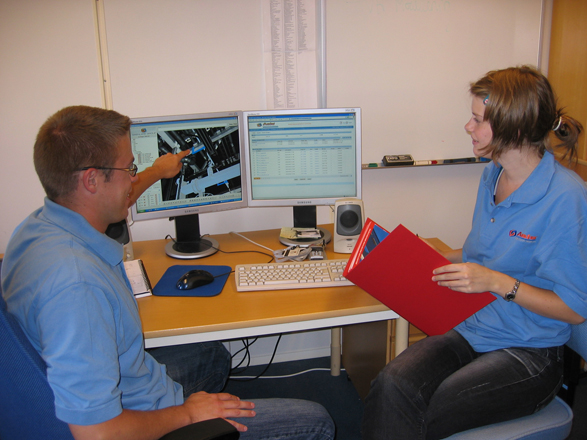On June 27 in Galveston, TX, Grenland Group launched its Qualified Partner Program (QPP) and demonstrated its new AIMS application for managing point clouds, 3D CAD, and standard office documents. I attended the meeting; here’s what I found. Jason Matsumoto, president of Grenland AsIs North America, Inc., reports that EDG Consulting Engineers (Houston, TX), Meridian Associates, Inc. (Beverly, MA), Sam O. Hirota, Inc. (Honolulu, HI), Satellite Data Systems (Dallas, TX) and Provide Solutions, LLC (Scottsdale, AZ) have all signed up to be beta testers for the AIMS application and as QPP members.
What is AIMS? Some asset owners and engineering firms that have adopted laser scanning-based work processes for engineering and construction are concluding that point cloud data needs to be managed. The data is much too valuable to be left cluttering up hard disks or, worse, discarded. At SPAR 2006 earlier this year in Houston, Terje Birkenes, Statoil ASA‘s representative for laser scanning contract technology and projects, articulated his company’s need to centralize control of all the point cloud data for a given asset. The data management issue begins with multiple service providers collecting scan data at different times with different scanners. To create the correct bid and work packages, the information has to be current. This means there is a need to archive, retrieve, visualize and partition point cloud data from multiple sources. AIMS is Grenland’s first answer to this data management requirement. Matsumoto says the company is initially targeting opportunities in the process industries but plans to address the needs of discrete manufacturing, building infrastructure, security and other sectors in the future.
AIMS’s visualization functionality is based on Octree‘s TrueSolid voxel technology. QPP meeting attendees were given a presentation by Octree founder Dr. Don Meagher on the fundamentals of voxel-based visualization, and why it is appropriate for point cloud data in general and clash detection in particular. Octree technology is used in a wide variety of applications ranging from medical imaging to modeling artillery shadows.
Designed as a web-based application, the AIMS user interface is built on AJAX (Asynchronous JavaScript and XML), which Matsumoto says provides fast response times for users. The server side of the application runs on 64-bit Windows Server 2003 using the 64-bit version of SQL 2005. Point cloud databases tend to be extremely large, so the company has developed a custom file transfer manager to overcome the 2GB limit imposed by standard HTTP file transfers. File transfers may be interrupted, then resumed up to 90 days later. In all, the AIMS Viewer is capable of displaying, marking up and printing over 230 different 2D and 3D file formats. Matsumoto says the first release of AIMS will run on Grenland’s enterprise-level AIMS network (20+ TB of storage with 50 Mbit/sec Internet connections), but the company plans to allow customers to run the application on their own servers by the end of 2006.
Grenland provides laser scanning and modeling services itself through its AsIs group, which is headed up by Jan Qvam, Global Manager, and Inge Byrkjeland, Technical Services Manager, and has more than 20 employees. Modeling services are provided in Stavanger, Norway and in Kuala Lumpur, Malaysia. Grenland says it plans to develop a worldwide network of qualified partners (QPP) to provide data capture services to its customers.
The Grenland kickoff took place at Galveston’s Ocean Star, an offshore drilling platform that’s been converted to a museum. The Ocean Star is home to some remarkable plastic models of offshore oil production and drilling platforms – a reminder of how clash detection used to be done, before 3D piping software became dominant and long before 3D laser scanning. The Ocean Star is on the water in Galveston’s ship channel – from the decks of the museum it’s quite evident that the offshore construction and platform repair business is booming in the Gulf of Mexico. Every yard appeared to be fully engaged, a consequence of high oil prices and residual hurricane damage from last summer.






